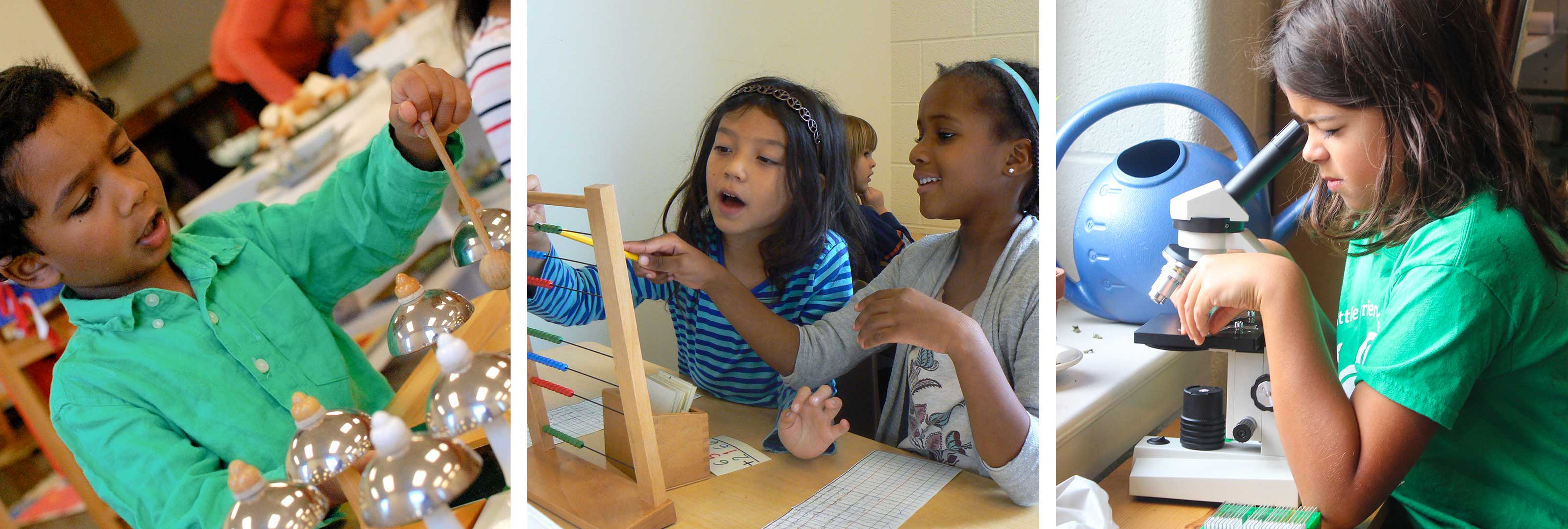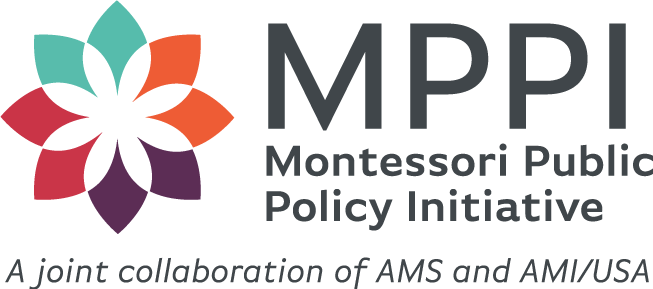Resources

Research
An Evaluation of Montessori Education in South Carolina’s Public Schools
“Researchers matched Montessori students to non-Montessori students with the same demographics and similar baseline academic performance. These matched analyses provided evidence that Montessori students experienced greater achievement growth in ELA, math, and social studies. Further, the benefits of Montessori extend beyond standardized test scores.”
Montessori Preschool Elevates and Equalizes Child Outcomes: A Longitudinal Study
A 3-year longitudinal study of children admitted through randomized lottery to public Montessori schools in a high-poverty American city. Montessori preschool elevated children’s outcomes in several ways including measures of academic achievement, social understanding, and mastery orientation. They also reported relatively more liking of scholastic tasks.
Removing Supplementary Materials from Montessori Classrooms Changed Child Outcomes
Examining how fidelity to the model impacts outcomes, this experiment looked at 3 classrooms which supplemented Montessori materials with other materials such as puzzles and games. Supplemental materials were removed from 2 of the 3 classrooms, and the students in those 2 classrooms showed significant growth in early reading and executive function along with greater growth in early math than in the classroom with supplemental materials
Journal of Montessori Research Spring 2016
A 3-year study of self-regulation in Montessori and non-Montessori classrooms
A comparison of public school Montessori and non-Montessori students in kindergarten through second grade found that Montessori children have higher levels of self-regulation and more consistent growth in self-regulation skills over the 3-year period of the study. Further, the researchers found an association between students’ levels of self-regulation and their academic success.
Montessori Life, June 2010
High School Outcomes for Students in a Public Montessori Program
High school graduates who had attended public Montessori programs from pre-school through 5th grade significantly outperformed peers who had not attended Montessori programs in measures of math and science.
Journal of Research in Childhood Education
Examining the Literature on Authentic Montessori Practices: Multi-Age Groupings
An exploration of mainstream education literature related to the core Montessori practice of multi-age groupings.
AMS Research Committee White Paper May 2016
Authentic Montessori: The Dottoressa’s View at the End of Her Life
A definition of authentic Montessori, outlining Maria Montessori’s understanding of the environment, the teacher and the child in order to “provide researchers, policy makers, administrators, teachers, and parents with a benchmark from which to measure and evaluate variations from the education method Dr. Montessori” created.
Journal of Montessori Research, Spring 2019
Frequently Asked Questions
Public policy encompasses laws, regulations, courses of action, and funding priorities created by a government entity or its representatives. It is created at the federal, state, and local level, and seeks to address a problem or issue, sometimes proactively, and other times reactively. It is “public” policy because it is made on behalf of the public, but the policies regulate and impact both the public and private sector.
No! Public policy impacts both the public and private sector. Child-care regulations, requirements to align with state standards, and other policies impact private Montessori schools.
There are many laws and regulations that impact Montessori programs. For example:
- Some states do not allow 5 or 6-year olds to be in the same classroom with three and four-year olds.
- Many states cap the number of children that can be in a classroom or have small adult-child ratios impacting ideal class size.
- Some states do not adequately recognize the Montessori teacher credential, so teachers are required to complete additional, non-Montessori coursework to be able to lead classrooms.
- Some states mandate that items that fit through a choke tube (think golden beads and button frames) cannot be in a classroom with children under 3 or under 4.
Advocacy work takes everyone’s involvement and is ongoing. Here are a few ways to get started:
- Get involved in your state advocacy group. Find your group here: XXXX MPPI can help you start one if your state does not yet have a group.
- Invite licensing specialists, state legislators and other policy makers to your school so they can see Montessori in action and be advocates on the inside.
- Get involved with child-care and education advocates beyond Montessori. Many states have NAEYC affiliates and other groups advocating on behalf of children. Your involvement ensures that the Montessori voice will be incorporated into their advocacy efforts.
- Learn more from MPPI. We regularly conduct short advocacy trainings at most major Montessori conferences and go in depth at our own annual advocacy conference.
The answer depends on your state. Child-care programs are either licensed through the state education agency, the state-level Department of Health and Human Services, or another state level department. In most states the licensing body depends on the age of the children served: depending on the age group and setting, programs may fall under the purview of a variety of state agencies.
Quality rating and improvement systems (QRIS) seek to define quality in early childhood settings, support programs in increasing their quality, and rate programs so parents can better understand varying levels of quality when selecting a setting for their children. QRIS systems are multi-level, differentiated performance assessments intended to increase transparency about program quality and incentivize continuous improvement among programs. Each state develops its own QRIS system which rates programs on their ability to meet increasingly rigorous sets of standards. The BUILD Initiative works with states to develop their QRIS systems and policies and has additional resources that provide useful context for understanding how these systems develop and what they incorporate in their rubrics. There are often financial incentives to participating in QRIS. In many of the profiled states, a program can only receive public early childhood funding if it participates in QRIS, and many others will use a tiered reimbursement structure where programs that have higher ratings on the state QRIS will receive higher reimbursement rates from state administered childcare subsidy programs than those with lower ratings.
Childcare licensing requirements set a minimum baseline of health, safety, and quality standards, which theoretically prevent programs that are developmentally or physically harmful to children from operating. Licensing rules regulate many facets of program operations, from building materials and staff qualifications to daily activities and parent involvement. Quality Rating and Improvement Systems take the same standards-based approach used in childcare licensing and expand it to define multiple performance levels rather than one minimum bar in order to recognize and incentivize higher levels of quality above licensure. Each state develops its own QRIS system which rates programs on their ability to meet increasingly rigorous sets of standards.
Teacher/student ratios: Many QRIS programs limit group sizes and adult/child ratios, tied to the state’s child-care licensing rules or NAEYC accreditation standards. In states where programs already feel challenged by their state’s licensing rules, tying these rules to the QRIS only increases that burden. Additionally, QRIS systems may require programs to have smaller group sizes or lower ratios in order to achieve a higher rating. This disadvantages Montessori programs which have larger group sizes and higher adult/child ratios by design.
Assessment: Most states’ QRIS require an observational assessment, such as the Early Childhood Environmental Rating Scale (ECERS), the Classroom Assessment Scoring System (CLASS), or another tool, and often more than one. These assessments reflect assumptions about what quality looks like in early childhood settings that differ from the Montessori approach. For example, if held to the standards in ECERS, a Montessori program would be faulted – and receive a lower QRIS rating – for not having a sand/water table in preschool classrooms. Montessori classrooms have materials that enable children to manipulate dry matter and liquids, similar to sand and water, in structured and unstructured environments, but following the letter of the ECERS assessment, the program wouldn’t meet the standard. MPPI has developed a crosswalk to the ECERS-3 to help educate ECERS raters and QRIS programs about what they will encounter in a Montessori classroom.
There are a number of advantages to participating in your state QRIS program:
- By participating you have the opportunity to demonstrate the high quality of Montessori programs. If Montessori programs are unranked, or automatically ranked low due to non-participation, parents searching for high quality settings for their children may not consider Montessori programs.
- You become a stakeholder which gives you more leverage to inform and reform your state QRIS rubric
- Participating in QRIS increases access for low-income families. In most states with a QRIS program, you need to participate in order to be a provider for families eligible to receive child-care subsidies.
A Registry is an information system states use for the early childhood and afterschool workforce that:
- Promotes professional growth and development
- Captures data about early childhood and afterschool practitioners in a variety of roles
- Is based on state career level systems that provide a framework for professional development
- Places individuals on a career level based upon verified educational information
- Recognizes and honors professional achievements of the early childhood and afterschool workforce
- Informs policy makers and partners
In certain contexts, state policy may not adequately recognize the rigorous preparation that Montessori teachers undergo in earning their Montessori credential. There are several contexts in which an individual’s Montessori credential may or may not be recognized: for state teacher licensure, under childcare regulations, and in workforce registries and career ladders. MPPI works with state advocacy groups to ensure Montessori teacher preparation is properly recognized in all contexts.
In traditional K-12 public schools, regardless of the state, teachers must have a BA and a state-issued license, typically obtained through the state education agency after completing a traditional, university-based preparation program or through some type of alternative certification process. For the majority of public schools, some private schools, and many early childhood programs, Montessori teachers must have a state-issued credential in order to teach. But in most states, Montessori teacher preparation programs are not recognized as approved programs. As a result, to teach in a Montessori school and have a state license, teachers effectively have to go through two training programs: one that meets state requirements, and one that meets Montessori requirements. Going through two programs is an expensive, time-consuming, and duplicative venture for both teachers and Montessori programs, and severely limits the supply of qualified staff. MPPI supports state advocacy groups seeking a pathway to teacher licensure for individuals with a Montessori credential from an AMS or AMI training program or a program accredited by MACTE.
MPPI’s focus is on policies that impede full implementation and/or funding of Montessori programs. Some examples include:
- Child-care regulations that limit core components of Montessori education including larger group sizes, higher adult-child ratios, 3-year mixed age groups, and certain materials or activities.
- Appropriate recognition of the Montessori teacher credential for state teacher licensure, in child-care regulations, and in workforce registries
- Mandated assessments and rating tools that are not well aligned with Montessori.
- Barriers to accessing and/or blending and braiding funding streams
Yes. While the bulk of education policy is at the state level, MPPI works with and alongside other educational organizations advocating for education policy at the federal level. The primary way in which the federal government impacts education is through federal funding streams for education. We are advocating to ensure Montessori programs can access those funding streams without compromising program implementation.
Yes. There are several Head Start Montessori programs throughout the country. In some cases, they are direct grantees, and in others, they are indirect grantees where an agency receives the funds and helps provide certain services and contracts out the educational services.
Yes, and doing so helps increase access to Montessori education. Rules and regulations around participation will vary by state and will most likely be linked to child-care regulations and/or a state’s QRIS system.
